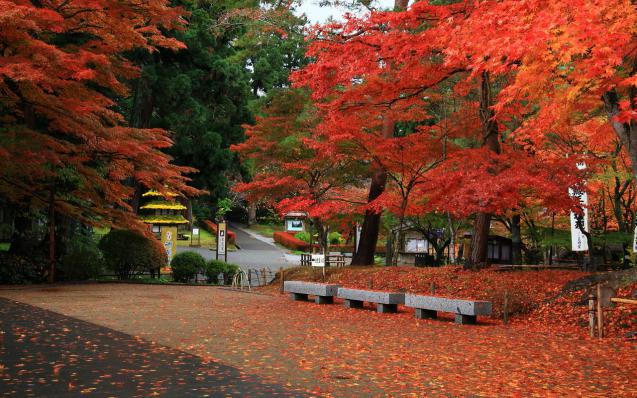
Hiraizumi Town is located in the southern part of Iwate Prefecture in the Tohoku Region, near the border with Miyagi. The town and environments of Hiraizumi are home to Buddhist temples, gardens, and other sites originally built by the Oshu Fujiwara family in the 12th century. Among these are the Chuson-ji (Special Historic Site), Motsu-ji (Special Historic Site), Kanjizaio-in Ato (Special Historic Site/Place of Scenic Beauty), Muryoko-in Ato (Special Historic Site) and Mt. Kinkeisan (Historic Site) which have been designated as a World Heritage Site for serving as representatives of Japan's unique Pure Land Buddhism ideology.
The buildings, gardens and archaeological sites composing the property of Hiraizumi are based on a syncretic Buddhism that had developed its unique character through fusion with indigenous Japanese forms of nature worship (often characterized as "Shinto") and which embodied Buddhist Pure Land thought, especially those associated with faith in Amida's Pure Land of Utmost Bliss.
The Cultural Heritage of Hiraizumi was inscribed on the World Heritage List at the 35th session of the World Heritage Committee, which was held in Paris, France in June 2011.
Things to see
To get around Hiraizumi Town and see the main attractions of the town, you can reach them on foot. However, bicycle hire is also available just to the right of the station, it is ¥1,000 for the whole day (lesser periods are available) it allows you to get around quickly and enjoyably.
Below are the list of City's attrations:
1. Ch?son-ji Temple, can be reached in 5 minutes by bus or 20 minutes on foot from the Hiraizumi Station. It is the largest and most famous temple, renowned particularly for its Golden Hall (They called it also "A world of Gold").
2. M?tsu-ji Temple, can be reached in 10 minutes on foot from the Hiraizumi station. It is the second of Hiraizumi's two large temples and known for its beautiful strolling gardens..
3. Takkoku no Iwaya Bishamon-do, About 30 minutes bike ride out of town. It is the 5th incarnation of the temple since it was established in 801 and it is dedicated to Bishamon the God of war, but was called Iwaya Bishamondo means a place to pray for peace.
4. Kanjizaio-in Ato. A large garden built by Fujiwara Motohira's wife.
5. Muryoko-in Ato. It is the temple's pond.
6. Yanaginogosho Iseki. This is the site of the former palace. Although no structures remain, the pond and foundations still give visitors an idea of how grand the palace once was.
7. Yanaginogosho Museum. A museum that provides a way for visitors to learn about Hiraizumi's history and the former palace.
8. Mt. Kinkeisan. Buddhist sutras were once buried on this mountain
Hiraizume can be accessed through the Hiraizumi "Run Run" Loop Bus which connects Hiraizumi Station with all the sites of interest in central Hiraizumi. It loops every 15-30 minutes from Hiraizumi Station to Motsuji, Chusonji, Takadachi Giekeido and back to the station. One ride costs 150 yen, while a day pass for unlimited rides is available for 400 yen.
However, there are also buses to Chusonji from both Ichinoseki and Hiraizumi stations or it is 10 minutes by taxi. Hiraizumi is on National Highway 4. From the Tohoku Expressway exit at Ichinoseki or Hiraizumi - Maesawa Interchange.
Hours and Fees:
Chuson-ji - The site is open daily from 8:30 AM to 17:00 PM and until 16:30 PM from November 4 through February but admission ends 10 minutes before closing time. Admission fee to Konjikindo and Treasure Hall is 800 yen.
Motsu-ji - The site is open daily from 8:30 AM to 17:00 PM and until 16:30 PM from November 5 to Aril 4. Admission fee is 500 yen.
Kanjizaio-in Ato and Muryoko-in Ato - These two sites are open at all times and no admission fee.
Submit Itinerary
Signup
- Sign Up
- Already a member? Login Now!
